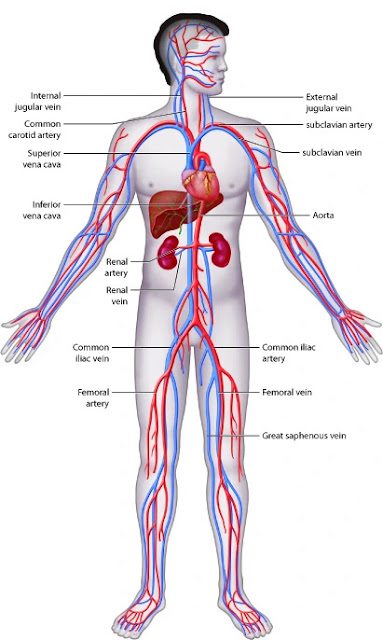Summarizing the functioning of systemic arterial system and venous system
In the fascinating realm of
biology, the human circulatory system takes center stage, orchestrating the
delivery of essential substances throughout the body. Two key actors in this
intricate performance are the arterial and venous systems, each with its unique
role.
 |
The functioning of systemic arterial system and venous system |
Arterial System:
The arterial system acts as the
body's thoroughfare, transporting oxygenated blood away from the heart and
supplying it to various organs and tissues. Imagine the aorta as the grand
boulevard, emerging directly from the heart's left ventricle. It's the main
conductor, branching into major arteries that lead to different parts of the
body.
Certainly! Here are the names of some of the main arteries in the human body:
- Aorta: The largest artery, originating from the left ventricle of the heart, and branching into smaller arteries to supply oxygenated blood to the entire body.
- Coronary Arteries: These arteries supply oxygenated blood to the muscles of the heart itself, ensuring its proper function.
- Carotid
Arteries: Major arteries in the neck that supply oxygenated blood to
the brain.
- Brachial
Artery: Located in the upper arm, it is a major vessel that supplies
blood to the arm and hand.
- Renal
Arteries: These arteries supply blood to the kidneys, playing a
crucial role in maintaining fluid and electrolyte balance.
- Mesenteric
Arteries: Arteries that supply blood to the intestines, facilitating
nutrient absorption.
- Iliac Arteries: Arteries that supply blood to the pelvic region and lower limbs. They further divide into internal and external iliac arteries.
Understanding these arteries
provides insight into the complex network responsible for distributing
oxygenated blood throughout the body.
As we navigate further, we
encounter the brachial arteries, delivering life-sustaining oxygen to the arms'
muscles and tissues. The renal arteries, akin to essential detours, supply the
kidneys with oxygen and nutrients, crucial for their role in maintaining fluid
and electrolyte balance.
Venous System:
Now, let's delve into the venous
system, the intricate pathway responsible for returning deoxygenated blood back
to the heart for renewal. Picture the vena cava as the main avenues converging
into the heart, collecting blood from various parts of the body.
Here are the names of some important veins in the human
body:
- Superior
Vena Cava: A large vein that carries deoxygenated blood from the upper
part of the body to the right atrium of the heart.
- Inferior
Vena Cava: Another large vein that transports deoxygenated blood from
the lower part of the body to the right atrium of the heart.
- Pulmonary
Veins: Four veins (two from each lung) that carry oxygenated blood
from the lungs to the left atrium of the heart.
- Jugular
Veins: Veins in the neck that carry deoxygenated blood from the head
and neck to the superior vena cava.
- Subclavian
Veins: Veins located beneath the clavicle that drain blood from the
arms and shoulders into the superior vena cava.
- Renal
Veins: Veins that carry deoxygenated blood from the kidneys to the
inferior vena cava.
- Hepatic
Veins: Veins that drain deoxygenated blood from the liver into the
inferior vena cava.
- Femoral
Vein: A major vein in the thigh that carries blood from the lower limb
to the common iliac vein.
- Popliteal
Vein: A vein located behind the knee that receives blood from the
small saphenous vein.
- Great
Saphenous Vein: A large vein in the leg that drains into the femoral
vein.
These veins, along with a vast
network of smaller veins, play a crucial role in returning deoxygenated blood
to the heart and facilitating the circulation of blood throughout the body.
Connection and Regeneration:
Capillaries: In
the circulatory symphony, capillaries act as the connecting bridges between the
arterial and venous systems. These minuscule vessels enable the exchange of
oxygen, nutrients, and waste products, refreshing the body's cells in the
process.
The regenerative power of the circulatory system is
awe-inspiring. The heart, much like a dedicated worker, pumps blood tirelessly,
ensuring that every nook and cranny of our body receives the necessary
nourishment. This constant renewal is fundamental to sustaining life and occurs
with each heartbeat.
As our exploration of the
circulatory system comes to an end, we've uncovered the vital roles played by
the arterial and venous systems. This journey provides a glimpse into the
wonders of our biological machinery, laying the groundwork for a deeper
appreciation of the delicate balance essential for optimal health and
well-being.

